Christmas Decoration
What Christmas Decorations Are Used in Mexico
2025
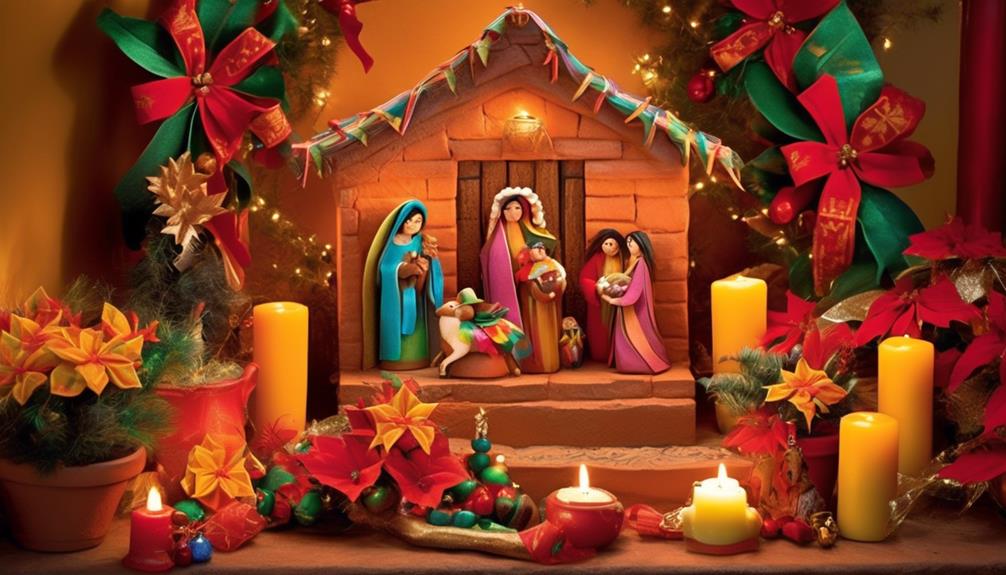
In Mexico, we fully embrace the holiday spirit by decking out our surroundings with a colorful and lively assortment of Christmas decorations.
From elaborate nativity scenes to whimsical piñatas, our holiday decor is an exquisite blend of tradition and creativity.
Our streets come alive with the warm glow of luminarias, while colorful papel picado dances in the breeze.
Delicate farolitos twinkle in the night, casting a magical spell upon our celebrations.
Garlands hang gracefully, adding a touch of elegance to our homes, and flickering candles create a cozy ambiance.
As we gather for the traditional processions of Posadas, the iconic Christmas star shines brightly above, guiding us through the joyous festivities.
In Mexico, our Christmas decorations are a testament to the beauty and richness of our culture.
Key Takeaways
- Nacimiento (Nativity Scene)
- Piñatas
- Luminarias
- Papel Picado
Nacimiento (Nativity Scene)
In Mexico, the Nacimiento, a traditional nativity scene, is a cherished and elaborate display that brings the story of Christmas to life. The Nacimiento is typically set up in homes, churches, and public spaces throughout the country during the holiday season. It's a representation of the birth of Jesus, featuring traditional figurines that depict not only the Holy Family but also other characters from the biblical story.
The Nacimiento is much more than just a decorative piece; it's a way of storytelling through decorations. Each figurine has its own significance and plays a role in telling the story of the nativity. For example, the figure of baby Jesus is placed in the center, symbolizing the reason for the season. The Virgin Mary and Joseph are positioned next to the baby Jesus, representing his parents. Other figures, such as the Three Wise Men, shepherds, and animals, complete the scene, adding depth and detail to the overall narrative.
The Nacimiento is often adorned with additional elements such as miniature trees, flowers, and even water features to create a visually stunning display. Families take great pride in setting up their Nacimiento, carefully arranging the figurines and decorations to create a beautiful and meaningful representation of the Christmas story. It serves as a reminder of the true meaning of Christmas and brings joy and reverence to those who observe it.
Piñatas

As we continue exploring the rich tapestry of Christmas decorations in Mexico, let's now turn our attention to the vibrant world of piñatas. These colorful and festive creations are an integral part of Mexican Christmas traditions, adding excitement and joy to the holiday celebrations.
Piñata Origins: Piñatas have a long history in Mexico, with their origins dating back to the ancient Aztec civilization. The Aztecs used clay pots adorned with feathers and filled them with precious offerings for the gods. This practice was later adopted by the Spanish conquistadors, who replaced the clay pots with paper mache.
Piñata Designs: Piñatas come in various shapes and sizes, ranging from traditional designs such as stars and spheres to more modern creations like animals, cartoon characters, and even vehicles. The designs are often bright and eye-catching, with intricate details and vibrant colors.
Breaking the Piñata: One of the highlights of Mexican Christmas celebrations is the piñata game. Blindfolded participants take turns trying to break the piñata with a stick, while others sing traditional songs and cheer them on. Once the piñata is broken, the goodies inside, such as candies, fruits, and small toys, are eagerly collected by the children.
Piñatas Beyond Christmas: While piñatas are most commonly associated with Christmas, they're also used in other festive occasions in Mexico, such as birthdays and weddings. The joy and excitement they bring make them a beloved tradition that has stood the test of time.
Luminarias
Luminarias are a traditional Christmas decoration in Mexico that add a warm and inviting glow to the holiday season. These outdoor paper lanterns are typically made by folding and cutting brown paper bags into intricate designs, then placing a lit candle inside.
Compared to other Christmas decorations, such as twinkling lights or sparkling ornaments, luminarias have a rustic charm that harkens back to simpler times.
Traditional Candle Lanterns
During the festive holiday season in Mexico, the warm glow of traditional candle lanterns illuminates the streets and homes, creating a mesmerizing ambiance. These traditional lanterns, known as Luminarias, are an integral part of Mexican Christmas decorations.
Here are four key aspects of these enchanting candle lanterns:
- Traditional lantern designs: Luminarias come in various designs, from simple paper bags with holes punched in them to intricate clay or glass lanterns. Each design showcases the creativity and craftsmanship of the Mexican artisans.
- Symbolism of candle lighting: The lighting of candles in these lanterns symbolizes the guiding light of the Star of Bethlehem, leading the way to the birthplace of Jesus. It represents hope, warmth, and the triumph of light over darkness.
- Street decorations: Luminarias line the streets during Christmas, creating a magical pathway for holiday revelers. Walking amidst the flickering candlelight is a truly captivating experience.
- Home decorations: Luminarias also grace Mexican homes, placed on windowsills, patios, and rooftops. Their soft, golden glow casts a cozy and inviting atmosphere, welcoming friends and family to celebrate the joyous season.
These traditional candle lanterns truly embody the rich cultural heritage and spiritual significance of Christmas in Mexico.
Outdoor Paper Lanterns
The streets of Mexico come alive with an ethereal glow as outdoor paper lanterns, known as Luminarias, illuminate the night during the festive holiday season. These enchanting lanterns are an integral part of the Mexican Christmas tradition, adding a touch of magic to the atmosphere. Luminarias are crafted from colorful paper and shaped into delicate, intricate designs. They are often hung on trees, fences, and buildings, creating a mesmerizing display that captivates both locals and visitors alike. The flickering candlelight inside the lanterns casts a warm and inviting glow, inviting people to gather and celebrate. The use of Luminarias showcases Mexico's creative and vibrant approach to festive decorations, showcasing the country's rich cultural heritage. The festive display techniques employed with these outdoor paper lanterns truly make Christmas in Mexico a sight to behold.
Papel Picado
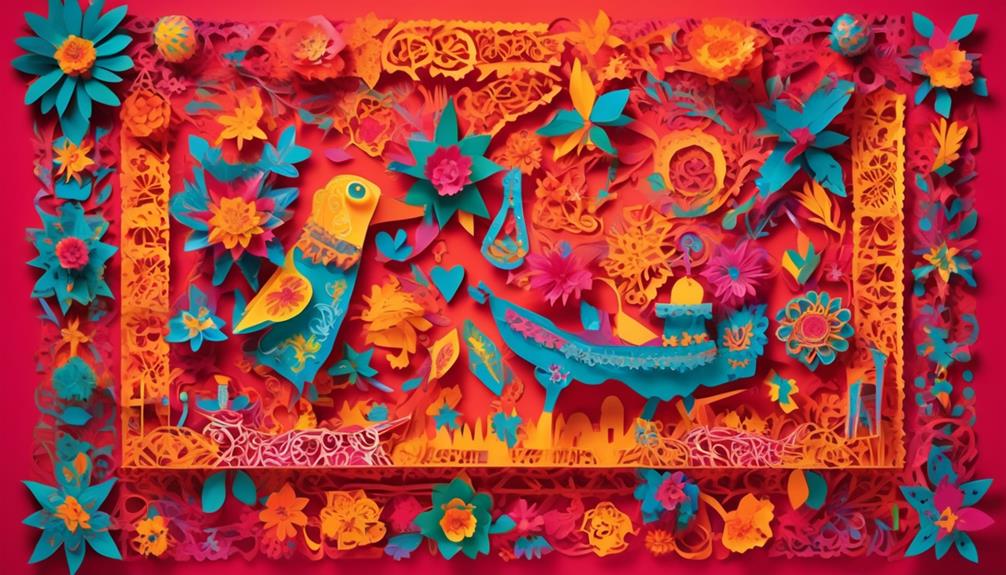
When it comes to papel picado, the vibrant colors and intricate designs are what immediately catch the eye. These delicate, hand-cut paper banners hold great traditional symbolism in Mexican culture, often depicting religious figures and scenes.
The festive display techniques, such as stringing the papel picado across streets or hanging them in doorways, create a lively and inviting atmosphere during the Christmas season.
Colors and Designs
As vibrant as a burst of confetti in the air, the papel picado decorations of Mexico infuse the Christmas season with a kaleidoscope of colors and intricate designs. These beautiful cut paper banners are a quintessential part of Mexican holiday celebrations, adding a festive touch to homes, streets, and churches.
Here are four key elements that make papel picado so unique:
- Festive Color Schemes: The papel picado decorations feature a wide array of vibrant hues, including red, green, blue, and yellow. These colors symbolize joy, abundance, and the Christmas spirit, creating a lively atmosphere.
- Traditional Mexican Patterns: The intricate designs on papel picado often draw inspiration from traditional Mexican motifs, such as flowers, stars, and geometric shapes. These patterns reflect the rich cultural heritage of Mexico and add a sense of authenticity to the decorations.
- Symbolic Imagery: Alongside the colorful patterns, papel picado may also incorporate symbols that hold special meaning during the Christmas season, such as angels, nativity scenes, and the iconic piñata. These images evoke religious and cultural significance, further enhancing the festive atmosphere.
- Handmade Craftsmanship: Each papel picado banner is meticulously cut by hand, showcasing the skill and craftsmanship of Mexican artisans. This labor-intensive process ensures that every piece is unique and carries a sense of tradition and artistry.
Traditional Symbolism
With its festive colors, intricate designs, and symbolic imagery, papel picado in Mexico transports us into a world steeped in traditional symbolism during the Christmas season.
This traditional art form consists of delicate paper cutouts that are carefully crafted by skilled artisans. Each cutout represents a different symbol or element of Mexican culture, such as flowers, birds, and religious figures.
The cultural significance of papel picado lies in its ability to convey important messages and emotions. The vibrant colors and intricate patterns serve as a visual language, expressing joy, hope, and spirituality.
These paper decorations are often displayed in homes, churches, and public spaces, creating a festive atmosphere and reminding people of the rich cultural heritage that surrounds the Christmas celebrations in Mexico.
Festive Display Techniques
Papel picado, the traditional Mexican art form of delicate paper cutouts, transforms spaces into vibrant and festive displays during the Christmas season. These intricate designs, crafted by skilled artisans, hang from ceilings, walls, and doorways, adding a touch of elegance to any space.
Festive display techniques using papel picado include:
- Layering: Multiple layers of cutouts are hung together, creating a stunning visual effect as the light filters through the intricate patterns.
- Color variations: Vibrant hues of red, green, and gold are commonly used, reflecting the Christmas spirit and adding a joyful ambiance to the decorations.
- Symbolic motifs: Papel picado often features traditional Christmas symbols such as angels, nativity scenes, and poinsettias, adding cultural significance to the displays.
- Cultural small token exchange: Papel picado is sometimes given as a small gift during Christmas celebrations, symbolizing the exchange of goodwill and spreading the festive cheer.
Through these festive display techniques, papel picado brings beauty, tradition, and cultural significance to the Mexican Christmas celebrations.
Farolitos (Little Lanterns)
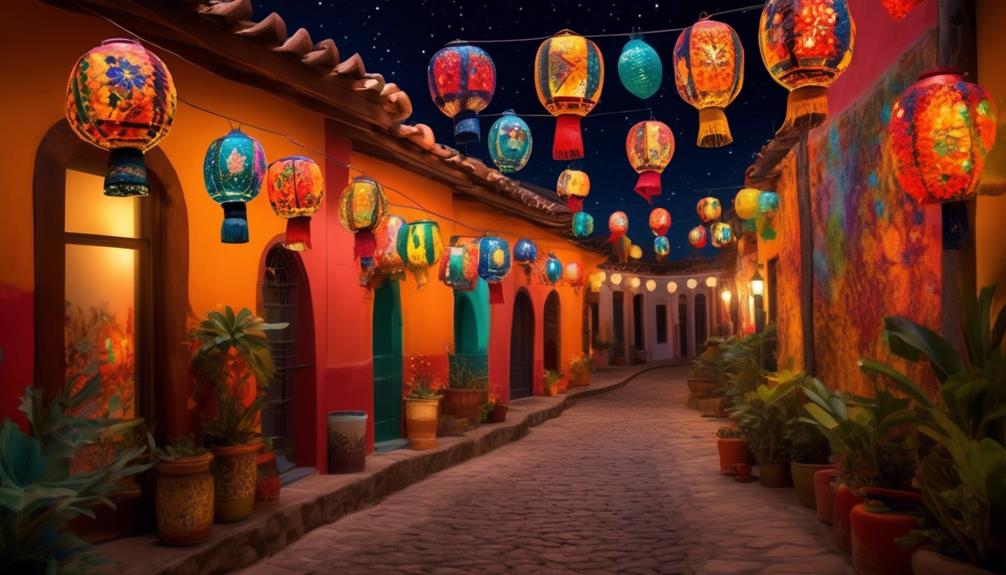
Farolitos, also known as little lanterns, illuminate the streets of Mexico during the festive season, creating a mesmerizing spectacle of warm, flickering lights. These enchanting decorations hold a special place in Mexican culture, symbolizing the guiding light of hope and joy during the Christmas season. Made from paper bags filled with sand and lit with candles, farolitos are carefully placed along sidewalks, rooftops, and windowsills, casting a soft glow that fills the air with a magical ambiance.
To fully grasp the significance of farolitos in Mexican culture, let's take a closer look at their characteristics and the emotions they evoke:
| Column 1 | Column 2 | Column 3 | Column 4 |
|---|---|---|---|
| Delicate | Fragile | Intricate | Vibrant |
| Handcrafted | Traditional | Time-consuming | Artistic |
| Romantic | Nostalgic | Whimsical | Enchanting |
| Inviting | Welcoming | Illuminating | Heartwarming |
The delicate and intricate designs of farolitos showcase the craftsmanship and attention to detail that goes into their creation. Handcrafted using traditional techniques, these decorations hold a sense of nostalgia and transport us to a simpler time. As the candles flicker inside, the vibrant glow casts a romantic and whimsical atmosphere, inviting us to embrace the joys of the holiday season. The warm and welcoming light they emit illuminates our hearts, filling us with a sense of enchantment and reminding us of the true spirit of Christmas.
Poinsettias
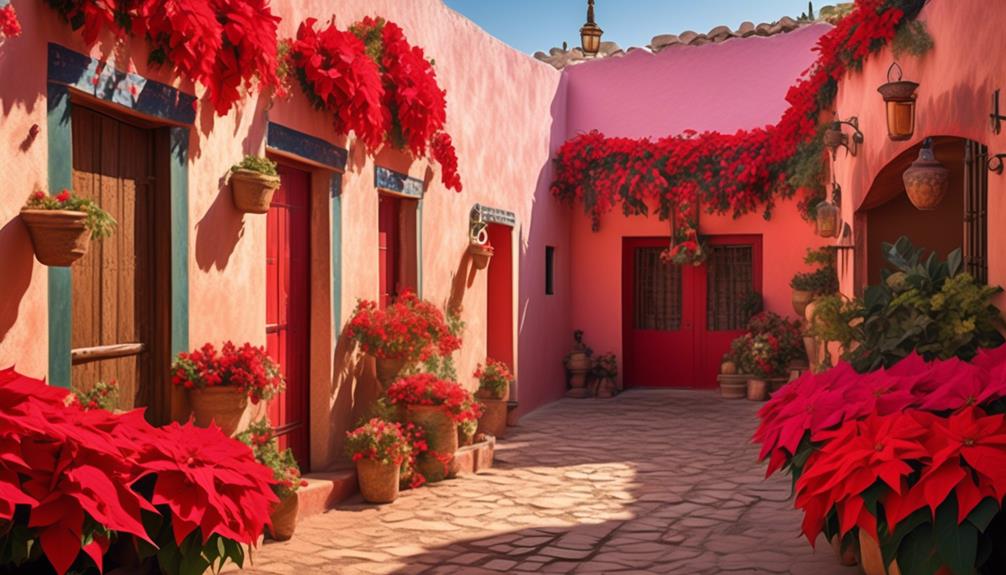
As we continue our exploration of Mexican Christmas decorations, we now turn our attention to the vibrant and iconic Poinsettias. These beautiful flowers, with their fiery red petals, have become synonymous with the holiday season in Mexico. Here are four fascinating facts about Poinsettias in Mexico:
- History: Poinsettias have a rich history in Mexican culture. They're native to Mexico and were first cultivated by the Aztecs, who believed they symbolized purity. In the 17th century, Spanish priests began using Poinsettias in Christmas celebrations, and their popularity spread throughout the country.
- Symbolism: Poinsettias are often associated with the Nativity story in Mexico. Legend has it that a young girl named Pepita, too poor to buy a gift for baby Jesus, picked weeds from the roadside. When she placed them in the church nativity scene, they transformed into beautiful Poinsettias.
- Care tips: Poinsettias are quite delicate and require special care. They prefer well-drained soil and indirect sunlight. It's essential to keep their soil moist but not overly wet. Poinsettias are also sensitive to cold temperatures, so be sure to keep them away from drafts.
- Cultural significance: Poinsettias aren't only used as decorations but also play a significant role in Mexican Christmas traditions. Many Mexican families place Poinsettias on their home altars or create elaborate displays in churches. These vibrant flowers are a symbol of love, hope, and new beginnings during the holiday season in Mexico.
Aguinaldos (Small Gifts)

When it comes to Christmas in Mexico, one of the highlights is the tradition of aguinaldos, or small gifts. These gifts are exchanged among family, friends, and even coworkers, as a way of spreading holiday cheer and showing appreciation.
While the gifts may be small in size, they carry a lot of meaning and are a cultural token of goodwill and celebration. These offerings often symbolize appreciation, strengthen bonds, and bring joy to those who receive them. In many traditions, even the tiniest of gifts can hold sentimental value, much like cherished, valuable Christmas decorations passed down through generations. Whether exchanged among friends or family, these thoughtful gestures help create lasting memories during the festive season.
Traditional Gift Exchange
During the Christmas season in Mexico, a traditional gift exchange known as Aguinaldos, involving small gifts, takes place. This cultural small token exchange is a cherished part of Mexican Christmas traditions. Here are four key aspects of the traditional gift exchange in Mexico:
- Aguinaldos: Aguinaldos are small gifts exchanged among family, friends, and coworkers during the holiday season. These gifts are often symbolic in nature, representing well-wishes and good luck for the coming year.
- Posadas: The gift exchange is often incorporated into the Posadas, a series of reenactments of Mary and Joseph's search for lodging. At the end of each Posada, participants exchange Aguinaldos as a gesture of gratitude and celebration.
- Handmade Crafts: Many Mexicans prefer to give handmade crafts as Aguinaldos. These crafts can include intricately woven textiles, pottery, or traditional ornaments, showcasing the rich cultural heritage of Mexico.
- Sweet Treats: Alongside handmade crafts, sweet treats like candies and chocolates are also popular Aguinaldos. These delicious gifts add a delightful touch to the gift exchange, bringing joy and sweetness to the holiday season.
The traditional gift exchange in Mexico exemplifies the spirit of Christmas, fostering togetherness and spreading joy through the exchange of meaningful tokens.
Meaningful Holiday Presents
The exchange of Aguinaldos, small gifts symbolic of well-wishes and good luck, is a cherished tradition that brings joy and togetherness to the Christmas season in Mexico. This meaningful holiday tradition is a unique cultural practice that holds deep significance for Mexican families.
Aguinaldos are typically given to children and represent the spirit of giving and sharing during this festive time. These small presents can range from toys and sweets to practical items like school supplies or small trinkets.
The act of exchanging Aguinaldos not only brings happiness to children, but also strengthens the bond between family members and friends. It's a beautiful way to express love, gratitude, and good wishes, creating lasting memories and fostering a sense of unity during the holiday season.
Cultural Small Token Exchange
Aguinaldos, cherished small tokens of well-wishes and good luck, embody the spirit of giving and togetherness during the Christmas season in Mexico. These cultural holiday traditions are a way for friends, family, and neighbors to exchange heartfelt gifts and express their love and appreciation for one another.
Here are four examples of aguinaldos commonly exchanged in Mexico:
- Nativity Scene Figurines: These miniature statues, known as 'nacimientos,' are intricately crafted and represent the birth of Jesus. People gift these figurines to add to each other's nativity scenes, creating a sense of unity and shared religious beliefs.
- Traditional Sweets: Delicious treats like sugar-coated peanuts, turrón, and Mexican hot chocolate are often given as aguinaldos. These culinary delights showcase the rich flavors and culinary heritage of Mexico, making them a delightful gift for anyone with a sweet tooth.
- Handmade Crafts: From colorful woven bracelets to intricately painted pottery, handmade crafts are highly valued as aguinaldos. These unique creations not only showcase the artistic talent of the gift giver, but they also promote the appreciation of cultural decorations and traditions.
- Ornaments: Christmas ornaments with Mexican motifs, such as papel picado (colorful paper cutouts) or miniature piñatas, are popular aguinaldos. These ornaments add a touch of cultural flair to Christmas trees and serve as a reminder of Mexican heritage and traditions.
Through the exchange of these aguinaldos, Mexico's cultural holiday traditions are celebrated and cherished, creating a sense of unity and joy during the Christmas season.
Christmas Trees
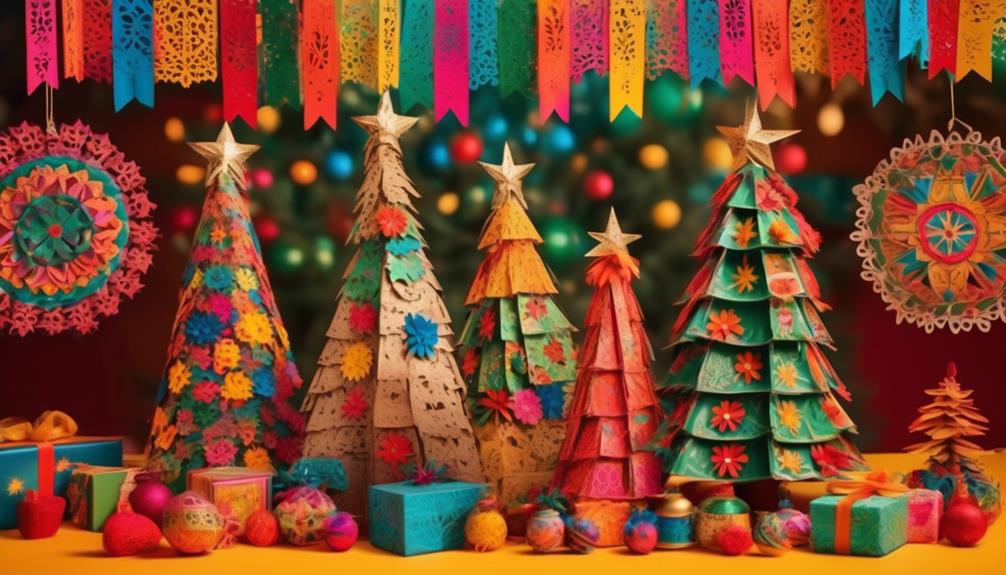
Christmas Trees in Mexico bring festive cheer to homes across the country, adorning living rooms with twinkling lights and vibrant ornaments. The tradition of decorating Christmas trees with traditional Mexican ornaments is deeply rooted in Mexican culture and holds great significance.
When it comes to decorating the Christmas tree, Mexican households showcase their creativity with an array of traditional ornaments. These ornaments often reflect the rich cultural heritage of Mexico, featuring colorful designs and symbols. From handcrafted clay figurines called 'nacimientos' depicting the nativity scene, to intricately woven papel picado (paper cutouts) representing various holiday motifs, Mexican Christmas trees are a vibrant display of artistry and tradition.
The Christmas tree itself holds a special place in Mexican culture. It's seen as a symbol of unity and family togetherness during the holiday season. Families gather around the tree to share heartfelt moments, exchange gifts, and create lasting memories. The tree serves as a focal point for celebrations, radiating warmth and joy throughout the home.
In addition to its cultural significance, the Christmas tree also serves as a way for Mexicans to embrace the global tradition of Christmas. It's a way for them to connect with the rest of the world during this festive season, while still incorporating their own unique customs and traditions.
Advent Wreaths

With its circular shape and vibrant colors, the Advent wreath is a cherished symbol of anticipation and preparation for the Christmas season in Mexico. As we delve into the cultural significance of Advent wreaths, let's explore the following key aspects:
- Traditional Materials: Advent wreaths in Mexico are typically made from evergreen branches, symbolizing eternal life. These branches are intricately woven together to form a circular shape, representing the eternal nature of God's love and the unity of the family during the holiday season.
- Symbolic Candles: The Advent wreath is adorned with four candles, each representing a different aspect of the Christmas story. The first candle symbolizes hope, the second represents peace, the third signifies joy, and the fourth symbolizes love. These candles are lit one by one on each Sunday leading up to Christmas, as a way to mark the passage of time and the anticipation of the birth of Jesus.
- Cultural Small Token Exchange: In some Mexican households, it's customary for family members to exchange small tokens or gifts during the lighting of the Advent wreath candles. This tradition serves as a reminder of the importance of sharing and spreading love during the Christmas season.
- Community Gatherings: Advent wreaths also play a central role in community gatherings and church services. Families and friends come together to light the candles, sing carols, and pray, fostering a sense of unity and celebration.
Tamales

As we continue our exploration of Christmas decorations in Mexico, let's now turn our attention to the beloved tradition of tamales.
Tamales are a staple of Mexican cuisine, and during the holiday season, they hold a special place in the hearts and stomachs of many. These delicious treats are made from masa, a dough made from corn, and filled with various ingredients such as meat, cheese, or vegetables. The dough is then wrapped in a corn husk and steamed to perfection.
Tamales aren't only a culinary delight, but they also hold cultural significance during Christmas. Families gather together to prepare tamales, turning the process into a joyful and communal event. It's a time for sharing stories, laughter, and passing down treasured holiday recipes from generation to generation.
What makes tamales even more special during Christmas is the wide variety of flavors and fillings that are prepared. From savory options like pork, chicken, or beef to sweet options like pineapple or cinnamon, there's a tamal for every palate. Tamales are often served as a main dish during Christmas celebrations, accompanied by other traditional Mexican dishes.
Guirnaldas (Garlands)

Colorful and vibrant, guirnaldas add a festive touch to Mexican homes during the holiday season. These garlands, made of various materials and adorned with different ornaments, hold great significance in Mexican culture.
Here are four key aspects that highlight the importance of guirnaldas as Christmas decorations in Mexico:
- Symbolism: Guirnaldas symbolize unity and the coming together of loved ones during Christmas. They're often hung in doorways and windows to welcome family and friends into the home.
- Materials: Guirnaldas are traditionally made from natural materials such as pine branches, flowers, and fruits. These elements not only contribute to the decorative appeal but also evoke a sense of nature and abundance.
- Colors: Bright and vibrant colors dominate Mexican guirnaldas, representing joy, celebration, and the lively spirit of the holiday season. Red, green, and gold are commonly used, reflecting traditional Christmas colors.
- Customization: Guirnaldas are often personalized with unique elements that hold special meaning to the family. This could include photographs, religious symbols, or handmade ornaments passed down through generations.
In Mexican culture, guirnaldas play a significant role in creating a warm and inviting atmosphere during Christmas celebrations. They serve as a visual reminder of the importance of family, tradition, and the shared joy of the holiday season.
Velas (Candles)
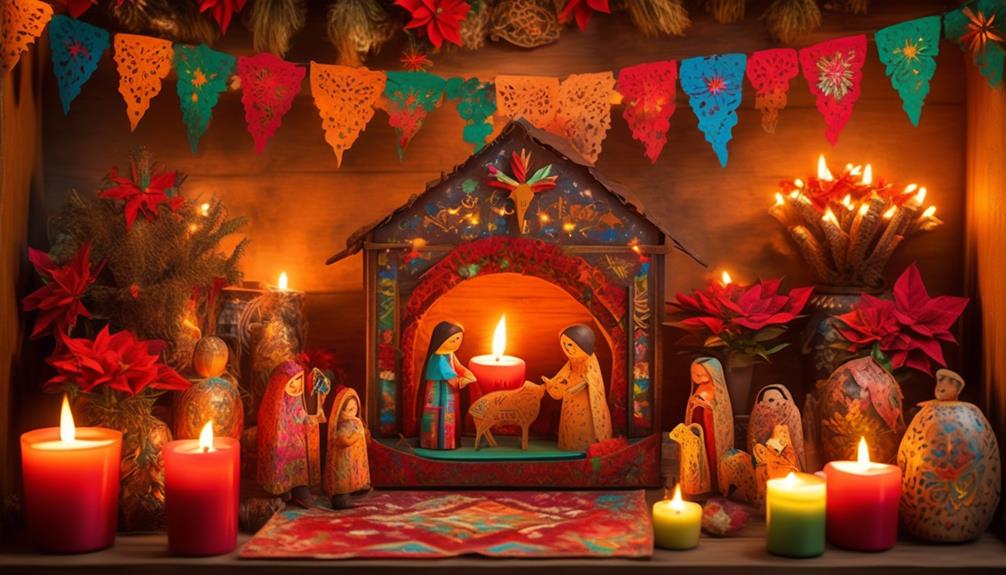
After adorning the doorways and windows with vibrant guirnaldas, another essential element of Christmas decorations in Mexico is the use of velas, or candles. In Mexican culture, velas hold significant symbolic traditions and are utilized in various decorative techniques during the holiday season.
Candles have long been associated with religious ceremonies and rituals in Mexico. During Christmas, they play a crucial role in creating a warm and inviting atmosphere. The flickering flames of the velas symbolize hope, faith, and the guiding light of the Virgin Mary and baby Jesus. They're often placed on windowsills, altars, and in the center of nativity scenes, illuminating the surroundings with their gentle glow.
Mexican artisans are known for their exquisite craftsmanship when it comes to candle making. Traditional decorative techniques include intricate carvings, vibrant colors, and the use of aromatic scents. Some velas are adorned with religious symbols or images of saints, while others feature intricate patterns inspired by indigenous art. These candles not only serve as decorative elements but also as cherished gifts exchanged during Christmas celebrations.
The use of velas in Christmas decorations in Mexico is a beautiful representation of the country's rich cultural heritage and deep-rooted religious beliefs. They bring warmth, beauty, and a sense of spirituality to the festive season, reminding us of the true meaning of Christmas.
Posadas (Traditional Processions)
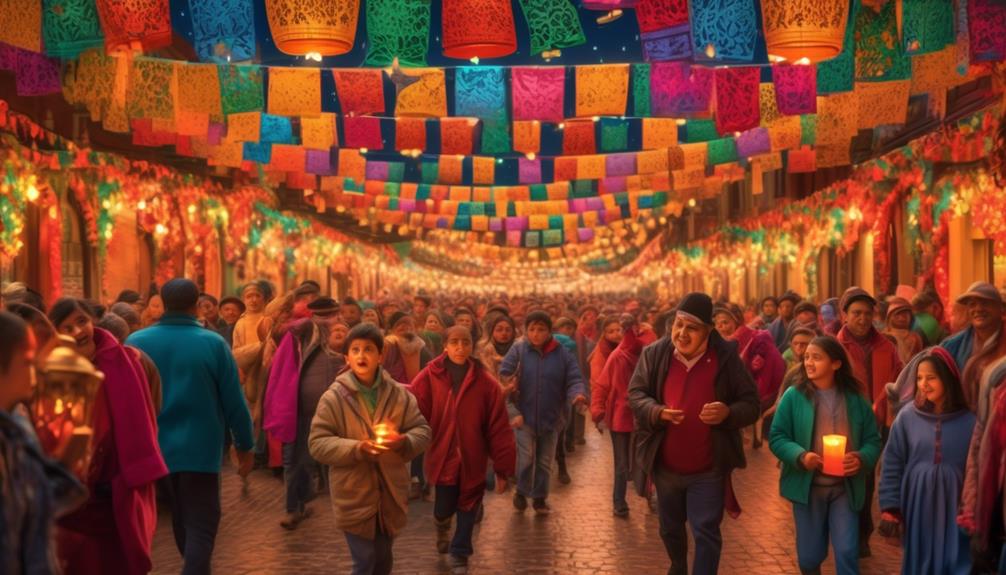
Posadas, a beloved tradition in Mexico, bring communities together in a joyous and symbolic procession during the Christmas season. These traditional processions are deeply rooted in Mexican culture and hold great religious significance. Here are four key elements that make posadas a unique and cherished part of Christmas celebrations in Mexico:
- Gathering of the Community: Posadas provide an opportunity for neighbors, friends, and family members to come together and celebrate the journey of Mary and Joseph as they sought shelter in Bethlehem. The processions often start at a designated home and move from house to house, reenacting the search for lodging.
- Singing and Praying: As the procession moves from one house to another, participants sing traditional Christmas carols known as 'villancicos.' These songs reflect the joyous spirit of the season and are accompanied by prayers and recitations of biblical passages.
- Estrella de Navidad: A key symbol in the posadas is the 'estrella de Navidad' or Christmas star. This star, often made of paper or other materials, is carried by one of the participants to guide the procession. It represents the star that led the Wise Men to the birthplace of Jesus.
- Breaking the Piñata: At the final stop of the posada, a piñata in the shape of a star or other traditional Christmas figures is hung. Participants take turns trying to break the piñata with a stick, symbolizing the struggle against evil. Once broken, the piñata releases candies and treats, symbolizing the joy and blessings of Christmas.
Posadas not only serve as a way to commemorate the nativity of Jesus but also foster a sense of community, unity, and joy during the Christmas season.
Estrella De Navidad (Christmas Star)
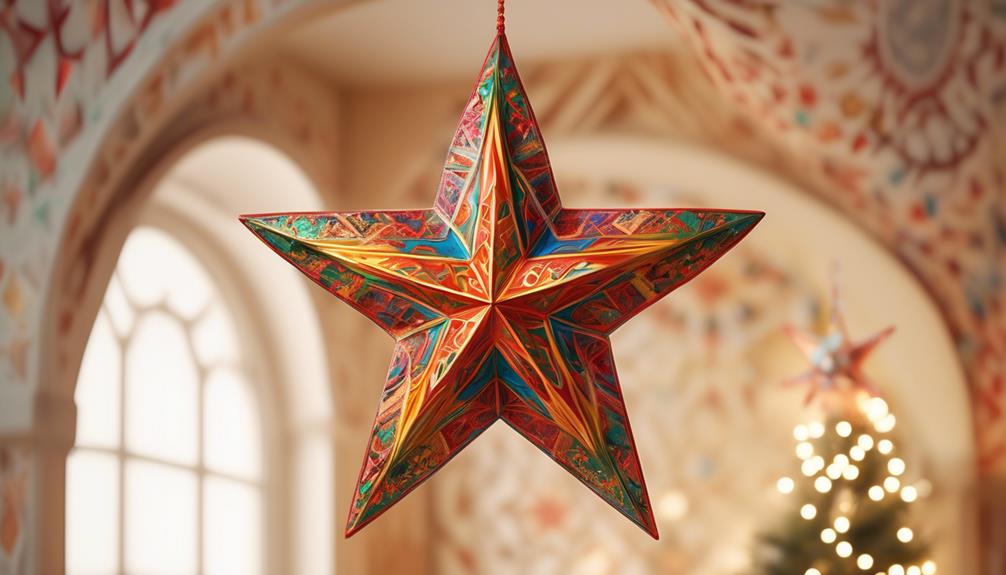
As the posadas procession continues its journey from house to house, the focal point becomes the Estrella de Navidad, a symbol of guidance and hope during the Christmas season in Mexico.
The Estrella de Navidad, also known as the Christmas Star, is a prominent feature in festive holiday decorations and is seen adorning homes and streets throughout the country.
This traditional Mexican ornament is typically made of colorful paper or plastic and is shaped like a star with multiple points. It's often illuminated from within, creating a beautiful glow that adds to the festive atmosphere.
The Estrella de Navidad is symbolic of the star that guided the Three Wise Men to the birthplace of Jesus, and it serves as a reminder of the hope and joy brought by the Christmas story.
Comparatively, the Estrella de Navidad stands out among other Christmas decorations due to its unique shape and significance. While many decorations focus on Santa Claus and gift-giving, the Estrella de Navidad represents the spiritual aspect of Christmas and the importance of faith.
Ethnographically, the Estrella de Navidad reflects the deep-rooted traditions and religious beliefs of the Mexican culture. It's a visual representation of the country's strong Catholic heritage and serves as a reminder of the true meaning of Christmas.
The Estrella de Navidad not only adds a touch of beauty to the holiday season but also serves as a symbol of unity and hope for all who celebrate.
Frequently Asked Questions
How Are Piñatas Traditionally Made and What Is Their Significance in Mexican Christmas Celebrations?
Traditional piñata making techniques vary across Mexico, but they generally involve shaping a clay pot, covering it with papier-mâché, and decorating it with colorful patterns. The cultural significance of piñatas in Mexican celebrations lies in their representation of overcoming obstacles and the joy they bring to festivities.
What Materials Are Commonly Used to Make Papel Picado and How Are They Used to Decorate During the Christmas Season?
We were fascinated to learn that papel picado, a traditional Mexican paper craft, is commonly made from tissue paper and used to decorate during the Christmas season. Its intricate designs add a festive touch to homes and celebrations.
What Is the History Behind the Tradition of Giving Aguinaldos (Small Gifts) During Christmas in Mexico?
The history of aguinaldos in Mexico is rich and fascinating. Traditional processions during Christmas in Mexico are filled with joy and excitement as small gifts are exchanged, creating a sense of unity and generosity.
How Are Christmas Trees Decorated in Mexico and What Are Some Unique Ornaments or Symbols Used?
In Mexico, Christmas tree traditions are vibrant and enchanting. We adorn our trees with unique ornaments and symbols, like colorful papel picado, beautiful piñatas, and intricate nativity scenes. It's a sight that truly captures the spirit of the season.
Can You Explain the Significance and Meaning Behind the Posadas (Traditional Processions) During the Christmas Season in Mexico?
Posadas in Mexico are traditional Christmas processions celebrated with great enthusiasm. They hold significant historical and cultural meaning, symbolizing the journey of Mary and Joseph looking for a place to stay. The processions involve singing, reenactments, and festive decorations.
Conclusion
As we take in the vibrant colors of papel picado and the warm glow of luminarias, we can't help but be transported to the bustling streets of Mexico during Christmas time.
The traditional decorations used in Mexico, from the nativity scenes to the piñatas, create a festive and joyful atmosphere that's unique to this rich culture.
It's a celebration that brings people together, reminding us of the power of traditions and the beauty of diversity.
- About the Author
- Latest Posts
Introducing Ron, the home decor aficionado at ByRetreat, whose passion for creating beautiful and inviting spaces is at the heart of his work. With his deep knowledge of home decor and his innate sense of style, Ron brings a wealth of expertise and a keen eye for detail to the ByRetreat team.
Ron’s love for home decor goes beyond aesthetics; he understands that our surroundings play a significant role in our overall well-being and productivity. With this in mind, Ron is dedicated to transforming remote workspaces into havens of comfort, functionality, and beauty.

Picture turning your used artificial Christmas tree into a beautiful garden ornament. By using some creativity and expertise, you can spruce up your garden for the holidays while also being environmentally conscious.
In this article, we’ll show you how to recycle artificial Christmas trees to decorate your garden. From selecting the right tree to preparing it for outdoor use, we’ll provide practical tips and creative ideas to help you repurpose your holiday tree and add a touch of magic to your outdoor space.
Key Takeaways
- Choose a tree size and shape that fits well in your garden space.
- Upcycle your artificial tree by adding bird feeders, hanging flower baskets, or string lights.
- Repurpose your tree with imagination and turn it into a unique garden decoration.
- Regularly water live branches and remove any dead or wilted foliage.
Selecting the Right Artificial Christmas Tree for Garden Decor
You should start by choosing the right artificial Christmas tree for your garden decor. An outdoor Christmas tree can be a stunning addition to your garden, adding a touch of festive charm. When selecting your tree, consider the size and shape that will fit best in your garden space.
Look for a tree that’s specifically designed for outdoor use, as it will be more durable and weather-resistant. Additionally, consider the style and color of your garden ornaments to ensure that your tree complements your existing decor.
Whether you prefer a traditional green tree or a more unique color, such as white or silver, there are plenty of options available. By selecting the right artificial Christmas tree, you can create a magical outdoor display that will delight both you and your guests.
Preparing the Artificial Christmas Tree for Outdoor Use
Get your outdoor space ready by making sure your artificial tree is properly prepared for use. Before placing your tree in the garden, consider upcycling options to give it a new purpose. You can transform your artificial tree into a unique garden decoration by adding bird feeders, hanging flower baskets, or even string lights. To ensure its longevity, weatherproofing techniques are essential. Here are some tips to protect your tree from the elements:
| Weatherproofing Techniques | Upcycling Options |
|---|---|
| Apply a waterproof sealant | Bird feeders |
| Use UV-resistant spray paint | Hanging flower baskets |
| Wrap the base with plastic | String lights |
Creative Ideas for Repurposing Artificial Christmas Trees in the Garden
Transforming your artificial tree into a unique garden decoration can add a touch of creativity to your outdoor space. Instead of throwing away your old Christmas tree, consider repurposing it for outdoor crafts and giving it a new life in your garden.
Here are some unique ways to use artificial Christmas trees in the garden:
-
Create a bird feeder: Hang pinecones filled with birdseed from the branches of the tree. The birds will love having a feeding station in your garden.
-
Make a wreath: Use the branches of the artificial tree to create a beautiful wreath for your garden gate or front door. Add some colorful decorations to make it truly unique.
-
Build a garden trellis: Use the sturdy branches of the tree to create a trellis for your climbing plants. It won’t only support their growth but also add a whimsical touch to your garden.
With a little imagination, you can repurpose your artificial Christmas tree and turn it into a one-of-a-kind garden decoration.
Tips for Decorating the Garden With Recycled Artificial Christmas Trees
Spruce up your outdoor space by repurposing your old holiday tree into unique decorations for your garden. Transforming your artificial Christmas tree into DIY outdoor Christmas tree decorations is a fun and eco-friendly way to add a festive touch to your garden all year round. Check out the table below for some creative ideas on how to repurpose your artificial Christmas tree:
| Decoration Idea | Materials Needed | How to Make |
|---|---|---|
| Miniature Tree | Tree branches, pots, decorations | Cut branches to desired length and attach to a small pot. Decorate with ornaments and lights. |
| Garland | Tree branches, wire | Bend wire into desired shape and attach branches. Hang as garland around fences or pergolas. |
| Bird Feeder | Tree branches, birdseed, wire | Attach branches together to form a platform. Fill with birdseed and hang from a tree branch. |
Now that you have some ideas for repurposing your artificial Christmas tree, let’s move on to the next section to learn how to maintain and care for these decorations in your garden.
Maintaining and Caring for Artificial Christmas Tree Decorations in the Garden
To keep your outdoor Christmas tree decorations looking their best, make sure to regularly water any live branches and remove any dead or wilted foliage. Caring for artificial Christmas tree decorations in the garden requires some attention and maintenance. Here are some tips to help you protect and maintain your artificial Christmas trees in the garden:
-
Provide proper support: Use sturdy stakes or a tree stand to secure your artificial tree in the garden, especially in windy conditions.
-
Clean regularly: Dust and debris can accumulate on your artificial tree, so make sure to clean it regularly with a soft brush or cloth to maintain its appearance.
-
Protect from harsh weather: Extreme weather conditions like heavy rain, snow, or strong winds can damage your artificial tree. Consider using a protective cover or moving it to a sheltered area during inclement weather.
Frequently Asked Questions
Can I Use a Real Christmas Tree for Garden Decor Instead of an Artificial One?
You can definitely use a real Christmas tree for garden decor instead of an artificial one. However, there are some benefits to using an artificial tree, such as durability and reusability.
How Do I Determine the Correct Size of Artificial Christmas Tree to Use in My Garden?
To determine the correct size of an artificial Christmas tree for your garden, measure the available space and consider the overall aesthetic you want to achieve. Choose a tree that fits well and complements your garden’s design.
Can I Leave My Artificial Christmas Tree Outside in All Weather Conditions?
You shouldn’t leave your artificial Christmas tree outside in all weather conditions. It’s important to protect it from harsh elements to ensure its longevity. Follow best practices for outdoor decoration to keep it looking great.
Are There Any Safety Precautions I Should Take When Repurposing an Artificial Christmas Tree in the Garden?
When repurposing an artificial Christmas tree in the garden, it’s important to take safety precautions. Follow these repurposing tips to ensure a safe and successful project.
How Often Should I Clean and Maintain My Recycled Artificial Christmas Tree Decorations in the Garden?
You should clean and maintain your recycled artificial Christmas tree decorations in the garden regularly. Dust and debris can accumulate, so a quick wipe-down and inspection every few weeks will keep them looking fresh and festive.
Conclusion
In conclusion, recycling artificial Christmas trees to decorate your garden is a practical and creative way to add a festive touch to your outdoor space. By selecting the right tree, preparing it for outdoor use, and implementing creative ideas for repurposing, you can create a unique garden decor that will impress your guests.
Remember to maintain and care for your artificial tree decorations to ensure they last for many seasons to come. Happy gardening!
- About the Author
- Latest Posts
Introducing Charles, the Editor in Chief at ByRetreat, whose passion for interior design and editorial excellence elevates every remote workspace to new heights. With his keen eye for detail, impeccable taste, and expertise in design, Charles brings a wealth of knowledge and creativity to the ByRetreat team.
As the Editor in Chief of a renowned lifestyle blog, Charles has honed his skills in curating captivating content and staying up-to-date with the latest trends in interior design. His deep understanding of aesthetics and the power of storytelling through design enables him to create remote workspaces that are not only visually stunning but also rich in personality and meaning.
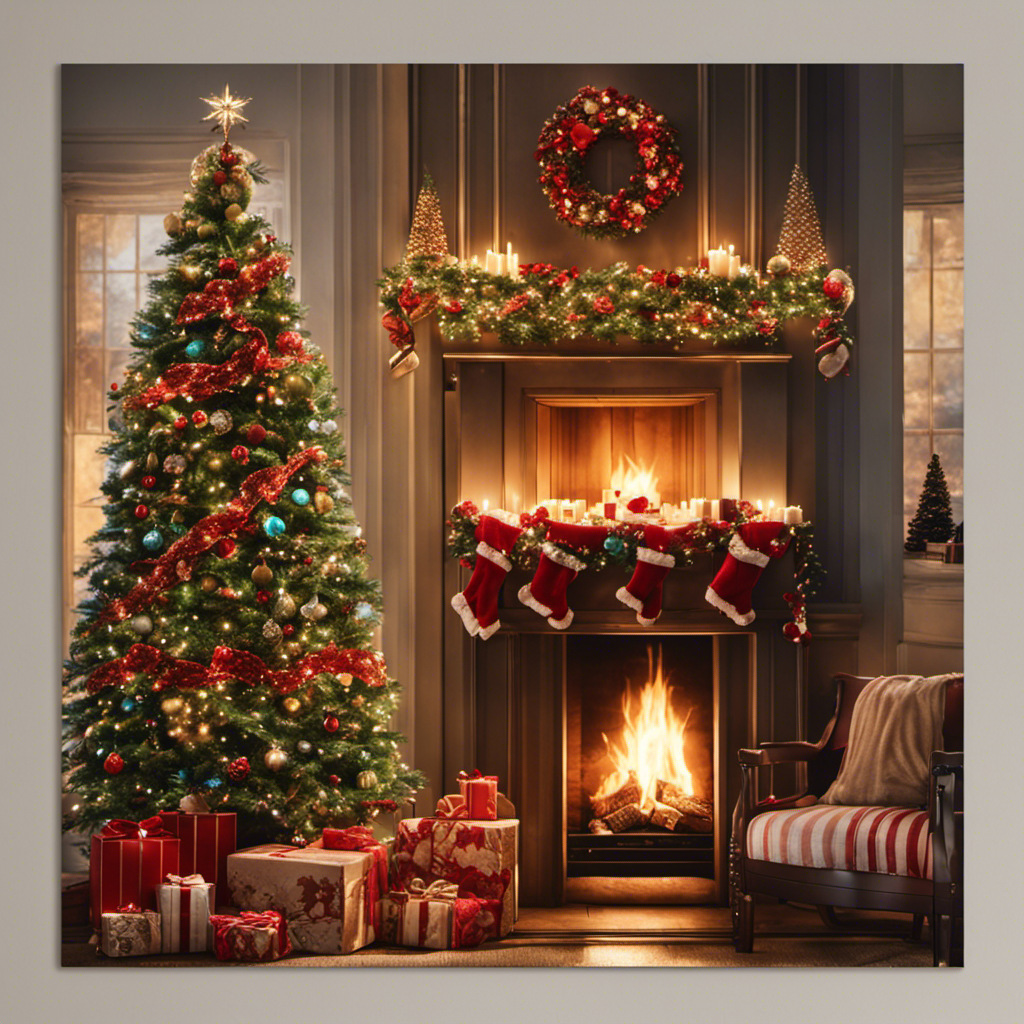
Have you ever thought about when is the right time to remove your Christmas decorations?
In the British tradition, there is a specific date that marks the end of the festive season. Known as Twelfth Night, it falls on January 5th, twelve days after Christmas Day.
This longstanding practice has its historical origins and regional variations across the UK. Understanding the significance of this tradition and its modern interpretation can add a touch of sophistication to your holiday celebrations.
Key Takeaways
- The tradition of taking down Christmas decorations originated in the Victorian era and was believed to bring bad luck if decorations were left up past Twelfth Night.
- Twelfth Night, celebrated on January 6th, marks the end of the Christmas season and symbolizes the visit of the three wise men to baby Jesus.
- The traditional date for taking down decorations is January 6th, but there are regional variations in the UK, with Scotland, Northern Ireland, and Wales having their own customs.
- Modern interpretation of the tradition allows for more flexibility, with some people choosing to take down decorations earlier or keep them up longer to extend the festive atmosphere.
Historical Origins of the Tradition
You might be wondering where the tradition of taking down Christmas decor originated. Well, let’s delve into its historical significance and cultural customs.
The tradition of removing Christmas decorations dates back to the Victorian era in Britain. During this time, Christmas trees were adorned with candles, ribbons, and ornaments, creating a festive atmosphere. However, it was believed that leaving the decorations up past Twelfth Night, which falls on January 5th or 6th, would bring bad luck for the coming year.
Twelfth Night is the traditional end of the Christmas season and marks the arrival of the Feast of the Epiphany. It symbolizes the visit of the three wise men to baby Jesus. Therefore, taking down the decorations before or on Twelfth Night became a customary practice in British culture.
Significance of the Twelfth Night
Celebrate the significance of the Twelfth Night by keeping your holiday decorations up until January 6th. This traditional date marks the end of the Christmas season and is rich in customs and superstitions. Here are three ways to embrace this festive occasion:
-
Wassailing: Gather with friends and family to go door-to-door, singing carols and sharing a warm drink to bless the orchards for a fruitful year ahead.
-
Twelfth Night Cake: Bake a delicious cake with a hidden bean and a pea. The person who finds the bean becomes the king or queen for the night, while the one who discovers the pea must be their servant.
-
Taking down decorations: On Twelfth Night, it’s believed that leaving Christmas decorations up beyond this date brings bad luck. So, bid farewell to the holiday season and prepare for the year ahead by carefully packing away your festive adornments.
As the Twelfth Night festivities come to an end, it’s time to explore the traditional date for taking down decorations.
Traditional Date for Taking Down Decorations
Bid farewell to the holiday season by adhering to the traditional date of January 6th for removing your festive adornments. This date, known as Twelfth Night, has been celebrated for centuries and holds cultural significance in many countries. The belief is that leaving decorations up beyond this date brings bad luck or hinders the arrival of spring.
While some may view this practice as superstitious, it’s an interesting cultural tradition that has stood the test of time.
In addition to cultural beliefs, there’s also an environmental impact to consider when it comes to keeping decorations up for longer periods. Many Christmas decorations are made from non-biodegradable materials, such as plastic and synthetic fibers, which can contribute to pollution and waste.
By adhering to the traditional date, you can minimize the environmental impact and ensure a more sustainable approach to celebrating the holiday season.
Regional Variations in the UK
In the UK, different regions have their own unique customs and practices when it comes to removing holiday decorations. Regional customs often reflect cultural differences and add a touch of diversity to this tradition. Here are three examples of regional variations in the UK:
-
In Scotland, it’s common to take down Christmas decorations on or before January 5th, which is known as ‘Twelfth Night.’ This date marks the end of the Christmas season and the arrival of Epiphany.
-
In Northern Ireland, some households adhere to the tradition of taking down decorations on January 6th, which is also known as ‘Little Christmas’ or ‘Women’s Christmas.’ This day is dedicated to women and is seen as the final opportunity to celebrate the festive season.
-
In Wales, it’s customary to remove decorations on January 7th, known as ‘Festival of Fools.’ This date is associated with a humorous celebration where people play pranks on each other.
These regional customs highlight the rich cultural tapestry of the UK and demonstrate how different communities interpret and celebrate the end of the Christmas season.
Now, let’s delve into the modern interpretation of this tradition.
Modern Interpretation of the Tradition
To put a unique spin on the end of the holiday season, you can embrace a modern interpretation of removing your festive decorations.
Traditionally, the British have followed the custom of taking down Christmas decorations on the twelfth night after Christmas, which falls on January 5th or 6th. However, in recent times, there’s been a shift in cultural significance and more flexibility in interpreting this tradition.
Some people now choose to take down their decorations earlier, either out of convenience or personal preference. Others may choose to keep them up longer, extending the festive atmosphere into the new year.
This modern interpretation allows individuals to personalize the end of the holiday season and reflect their own values and desires, adding a touch of individuality to an age-old tradition.
Frequently Asked Questions
What Are Some Common Types of Christmas Decorations Used in the Uk?
In the UK, people use different types of Christmas decorations. Traditional decorations, like Christmas trees and ornaments, are popular. Some prefer homemade decorations, while others opt for store-bought ones. Christmas lights and fairy lights are also commonly used.
How Do Other Countries Celebrate the End of the Christmas Season?
Different countries have their own unique ways of celebrating the conclusion of the Christmas season. From Spain’s Three Kings Day to Russia’s Old New Year, these end of season festivities showcase cultural diversity and traditions.
Are There Any Specific Rituals or Ceremonies Associated With Taking Down Christmas Decorations in the Uk?
In the UK, taking down Christmas decorations involves various rituals and ceremonies. These practices carry cultural significance and have historical origins. Some alternative traditions have also emerged over time.
Has the Tradition of Taking Down Christmas Decorations on the Twelfth Night Always Been Practiced in the Uk?
The tradition of taking down Christmas decorations on the twelfth night has not always been practiced in the UK. Its historical origins can be traced back to ancient times. However, attitudes towards this tradition have changed in modern-day UK.
Are There Any Superstitions or Beliefs Associated With Leaving Christmas Decorations up Past the Traditional Date for Taking Them Down?
Leaving up Christmas decorations past the traditional date can be seen as bad luck or a sign of laziness. It is important to respect the cultural significance of taking them down on time to avoid any negative superstitions.
Conclusion
So, you’ve finally reached the end of the festive season, and it’s time to bid farewell to your beloved Christmas decorations.
According to tradition, you should wait until the Twelfth Night to take them down. But let’s be honest, who’s got the time or patience for that?
In this modern age, we don’t need to stick to ancient customs. So go ahead, break the tradition, and take down those decorations whenever you please.
After all, rules were made to be broken, right?
- About the Author
- Latest Posts
Introducing Ron, the home decor aficionado at ByRetreat, whose passion for creating beautiful and inviting spaces is at the heart of his work. With his deep knowledge of home decor and his innate sense of style, Ron brings a wealth of expertise and a keen eye for detail to the ByRetreat team.
Ron’s love for home decor goes beyond aesthetics; he understands that our surroundings play a significant role in our overall well-being and productivity. With this in mind, Ron is dedicated to transforming remote workspaces into havens of comfort, functionality, and beauty.
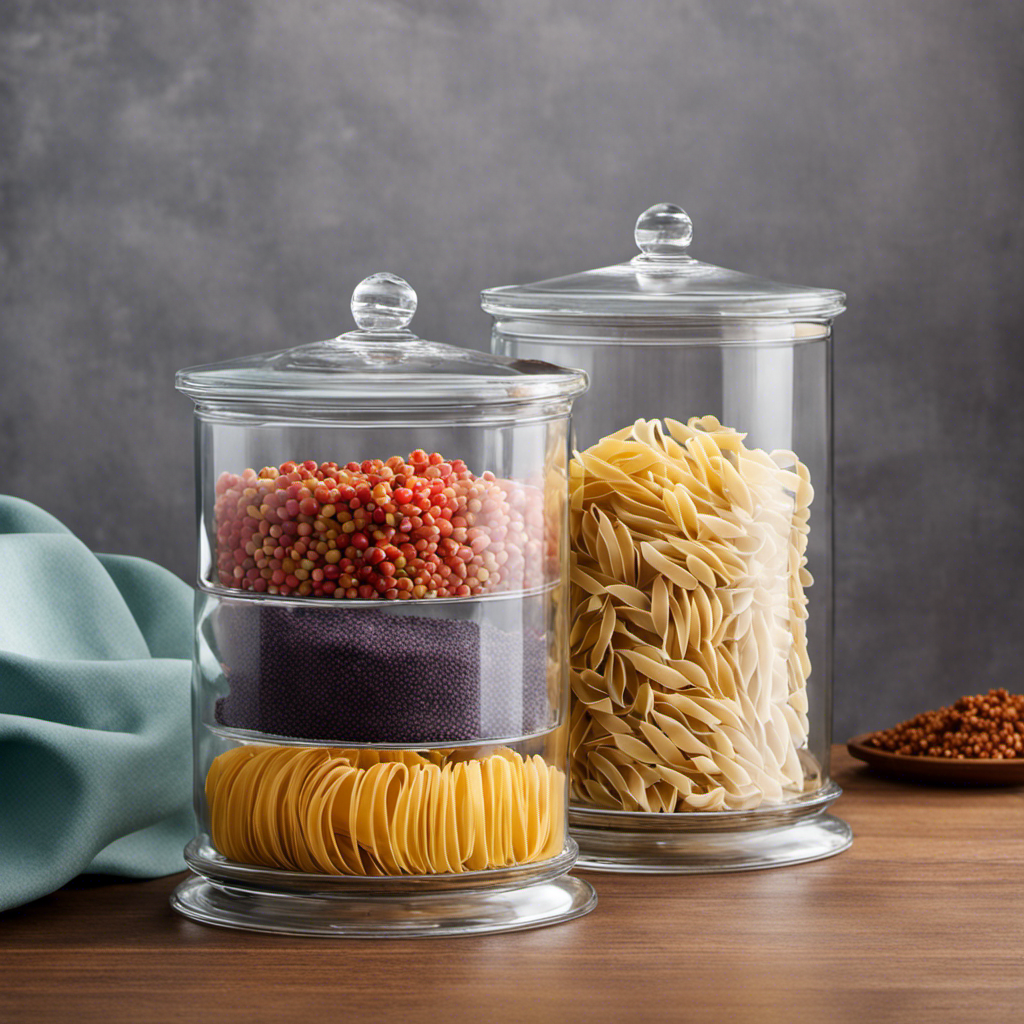
Hey everyone! Have you ever faced difficulties in enhancing your kitchen decor? Don’t worry, because I have some great ideas on what to put in those clear canisters. Believe me, it will make a big difference.
From fresh herbs and spices to colorful dry pasta, and even assorted baking supplies, the options are endless.
Oh, and let’s not forget about dried fruits and nuts, or the heavenly aroma of coffee beans and tea leaves.
Get ready to transform your kitchen into a stylish and functional space!
Key Takeaways
- Fresh herbs and spices bring freshness and vitality to the kitchen
- Colorful dry pasta adds pop of color and personality to the kitchen
- Organized baking supplies save time and add elegance to the kitchen
- Coffee beans and tea leaves in clear canisters add elegance and aroma to the kitchen
Fresh Herbs and Spices
I love filling clear canisters with fresh herbs and spices to add a burst of flavor and color to my kitchen decor.
One of my favorite ways to incorporate herbs into my kitchen is by creating an indoor herb garden. It not only adds a touch of greenery but also provides me with a convenient source of fresh herbs for cooking.
I enjoy the process of selecting different herbs like basil, rosemary, and thyme, and nurturing them as they grow. Not only do they enhance the aroma and taste of my dishes, but they also bring a sense of freshness and vitality to my kitchen.
Additionally, I enjoy experimenting with DIY spice blends. By combining different spices like cumin, paprika, and garlic powder, I can create unique flavors that perfectly complement my culinary creations. Having these spice blends readily available in clear canisters not only adds a decorative touch to my kitchen but also makes it easy for me to access and use them while cooking.
Colorful Dry Pasta
My favorite way to spruce up my kitchen is by using colorful dry pasta as a vibrant and eye-catching decorative element in my home. Not only does it add a pop of color, but it also brings a touch of whimsy and personality to my kitchen decor.
Here are some ideas to inspire you:
-
Different Shaped Pasta: From bowties to spirals, there are so many unique and interesting pasta shapes available. Mix and match them to create a visually appealing display in your clear canisters.
-
Vintage Kitchen Utensils: Pair your colorful dry pasta with vintage kitchen utensils to create a charming and nostalgic vibe. Hang old whisks, spatulas, and ladles on the wall or display them in a jar alongside the pasta.
-
Layered Pasta: Create layers of different colored pasta in your canisters for a stunning visual effect. This is a simple yet effective way to add depth and dimension to your kitchen decor.
Assorted Baking Supplies
One way to organize my assorted baking supplies is by using labeled containers to easily identify and access the ingredients and tools I need.
For my decorative sprinkles, I’ve a clear glass jar that showcases the vibrant colors and textures. It adds a pop of excitement to my kitchen decor, while also keeping my sprinkles fresh and easily accessible.
Another container I use is a small plastic bin for my cookie cutters. I label it ‘Cookie Cutters’ and place it on a shelf within reach. This way, whenever I’m in the mood for baking cookies, I can quickly find the perfect shape without rummaging through drawers.
Organizing my baking supplies in this way not only saves me time but also adds a touch of elegance to my kitchen.
Dried Fruits and Nuts
To keep my dried fruits and nuts fresh, I store them in airtight containers. Not only do dried fruits and nuts add a burst of flavor and texture to any dish, but they also come with numerous health benefits.
Here are some reasons why you should incorporate them into your diet:
- Boost of nutrients: Dried fruits and nuts are packed with essential vitamins, minerals, and antioxidants that promote overall well-being.
- Energy-packed snacks: Whether you’re on-the-go or need a pick-me-up during the day, dried fruits and nuts provide a quick and nutritious energy boost.
- Versatile ingredients: Get creative in the kitchen by using dried fruits and nuts in a variety of recipes, from salads and baked goods to savory dishes like stir-fries and pilafs.
Coffee Beans and Tea Leaves
I love the aroma of freshly ground coffee beans and the soothing taste of steeped tea leaves. There’s something magical about starting the day with a cup of freshly brewed coffee or a fragrant cup of tea.
When it comes to kitchen decor, clear canisters filled with coffee beans and loose leaf tea are a perfect choice. Not only do they add a touch of elegance to the kitchen, but they also serve a practical purpose. The rich, earthy scent of coffee beans fills the air, creating a warm and inviting atmosphere.
The canisters can be arranged on a countertop or displayed on a shelf, allowing you to showcase your favorite blends. To enhance the visual appeal, you can also add a few sprigs of aromatic herbs like lavender or mint to the canisters. This not only adds a pop of color but also infuses a subtle herbal fragrance into the air.
Frequently Asked Questions
How Can I Properly Store Fresh Herbs and Spices to Maintain Their Freshness and Flavor?
To properly store herbs and spices for freshness, I recommend using clear canisters. This allows you to easily see and access your collection. Ensure they are tightly sealed to maintain flavor and store in a cool, dry place away from sunlight.
What Are Some Creative Ways to Display Colorful Dry Pasta in Clear Canisters?
I love finding creative ways to display colorful dry pasta in clear canisters. It’s a great way to add a pop of color to my kitchen decor. I also enjoy showcasing fresh flowers and colorful candy for a fun and vibrant look.
How Should I Organize and Store Assorted Baking Supplies in Clear Canisters for Easy Access?
I love using clear canisters to organize and store my assorted baking supplies. It’s a great way to keep everything easily accessible. I also have some ideas for organizing small kitchen appliances and tips for storing bulk grains and flours.
Can I Store Dried Fruits and Nuts Together in the Same Clear Canister or Should They Be Stored Separately?
Storing dried fruits and nuts together in a clear canister can be convenient, but it may affect their flavors and textures. Separating them ensures freshness and prevents cross-contamination.
What Are Some Tips for Selecting and Storing Coffee Beans and Tea Leaves in Clear Canisters to Preserve Their Flavor and Aroma?
When it comes to selecting canister sizes for coffee beans and tea leaves, it’s important to consider the quantity you typically use. To preserve their flavor and aroma, clean and maintain clear canisters regularly.
Can Clear Canisters Be Used to Display Christmas Decorations in the Kitchen?
Yes, clear canisters can beautifully showcase Christmas decorations for kitchen. Fill them with festive items like colorful cookie cutters, candy canes, mini ornaments, or cinnamon sticks. The transparent containers allow you to create a visually appealing holiday display while keeping your kitchen organized and festive.
Conclusion
In conclusion, filling clear canisters with various ingredients not only adds a decorative touch to your kitchen but also serves a practical purpose.
From fragrant herbs and spices to vibrant pasta and versatile baking supplies, the options are endless.
Don’t forget to include dried fruits and nuts for a healthy snack option, and coffee beans or tea leaves for a delightful caffeine fix.
Remember, the world is your oyster when it comes to kitchen decor, so let your creativity run wild!
- About the Author
- Latest Posts
Meet Bethia, the visionary designer at ByRetreat who brings a touch of magic to every remote workspace she creates. With a boundless imagination and an eye for beauty, Bethia is passionate about transforming ordinary spaces into extraordinary havens of creativity and comfort.
Bethia possesses a unique talent for envisioning the perfect combination of furniture, colors, and textures that harmonize seamlessly in a room. She understands that selecting furniture goes beyond mere functionality; it’s about curating pieces that evoke a sense of style and sophistication while enhancing the overall ambiance.
-

 Decor2 weeks ago
Decor2 weeks agoMaximalist Decor Explained: Embrace More Style
-

 Vetted3 weeks ago
Vetted3 weeks ago15 Best Foot Massagers for Neuropathy to Soothe Your Feet and Relieve Discomfort
-

 Vetted4 weeks ago
Vetted4 weeks ago15 Best Sports Laundry Detergents for Keeping Your Activewear Fresh and Clean
-

 Vetted4 weeks ago
Vetted4 weeks ago15 Best Tall Toilets for Seniors That Combine Comfort and Safety
-

 Vetted6 days ago
Vetted6 days ago15 Best Cleaners for Fiberglass Showers to Keep Your Bathroom Sparkling Clean
-

 Vetted2 weeks ago
Vetted2 weeks ago15 Best Organic Pest Control Solutions for a Naturally Pest-Free Home
-

 Decor3 weeks ago
Decor3 weeks agoWhere the Wild Things Are Nursery Decor
-

 Architecture Home Styles4 weeks ago
Architecture Home Styles4 weeks agoExploring the Difference Between Traditional and Contemporary Styles





























